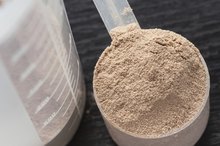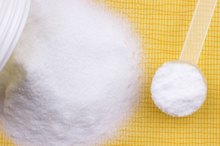Does Creatine Give People Anger Problems?
A misunderstanding of what creatine supplements are and how they work may exist for people unfamiliar with them. Creatine is not a type of steroid -- it is a natural substance produced by your body in the kidneys, pancreas and liver. Most creatine in your body is stored in muscle tissue. Creatine supplements help increase the amount of stored creatine, called phosphocreatine. This may be beneficial for resistance-trained athletes. Side effects of creatine supplementation are minimal for most people when consumed per the recommended dose. Check with your doctor before trying creatine supplements because they’re not for everyone.
If you are experiencing serious medical symptoms, seek emergency treatment immediately.
Mood Swings
Mood swings or anger problems are not associated with creatine supplementation, according to the University of Maryland Medical Center 1. You may be confusing creatine with supplements that affect your testosterone levels. According to the University of California Los Angeles, supplements that increase testosterone levels, such as:
- anabolic steroids
- can cause increased aggressiveness
- commonly referred to as “roid rage.” Creatine doesn’t affect testosterone levels
- so mood swings shouldn’t be an issue when taking these supplements 1
How it Works
The Effects of Creatine With Body Weight Exercises
Learn More
Creatine supplements increase phosphocreatine levels in your muscle tissue by about 25 percent, according to UCLA. This is significant because creatine plays a major role in providing energy to your muscles. It basically allows you to do more repetitions and sets in the gym. The result is an increased ability to build muscle. Your muscle tissue can only store a certain amount of phosphocreatine, so supplementing beyond the recommended dosage will not provide better results; excess creatine simply exits your body via the urine.
- Creatine supplements increase phosphocreatine levels in your muscle tissue by about 25 percent, according to UCLA.
- Your muscle tissue can only store a certain amount of phosphocreatine, so supplementing beyond the recommended dosage will not provide better results; excess creatine simply exits your body via the urine.
Side Effects/Safety
Common side effects associated with creatine supplementation include muscle cramping, stomach discomfort and nausea. Serious issues arise when consuming creatine beyond its recommended dosage, such as kidney and liver problems. The most common side effect is weight gain, which is typically 1.5 to 4.5 pounds, according to UCLA. Most of this weight is because of water retention. Dehydration can occur if you don’t increase your intake of fluids during supplementation.
- Common side effects associated with creatine supplementation include muscle cramping, stomach discomfort and nausea.
- The most common side effect is weight gain, which is typically 1.5 to 4.5 pounds, according to UCLA.
Dosage
Is Creatine a Safe Supplement for Teenagers?
Learn More
According to UMMC, adult strength-training athletes should take up to 20 grams of creatine per day in 5-gram increments for five to seven days. Creatine maintenance consists of taking 2 to 5 grams of creatine per day with carbohydrates and protein. UCLA suggests not taking creatine for longer than a couple months at a time. Endurance athletes, such as runners or cyclists, will not benefit from creatine supplements, according to UMMC.
- According to UMMC, adult strength-training athletes should take up to 20 grams of creatine per day in 5-gram increments for five to seven days.
Related Articles
References
- University of Maryland Medical Center: Creatine
- Cooper Institute: Creatine Supplements: Friend or Foe for Exercise Performance?
- Kreider, R. B. International Society of Sports Nutrition position stand: safety and efficacy of creatine in exercise, sport, and medicine. Journal of International Society of Sports Nutrition. 2017; 14: 18.
- MedlinePlus. Creatine.
Writer Bio
Joseph Eitel has written for a variety of respected online publications since 2006 including the Developer Shed Network and Huddle.net. He has dedicated his life to researching and writing about diet, nutrition and exercise. Eitel's health blog, PromoteHealth.info, has become an authority in the healthy-living niche. He graduated with honors from Kellogg Community College in 2010 with an Associate of Applied Science.









